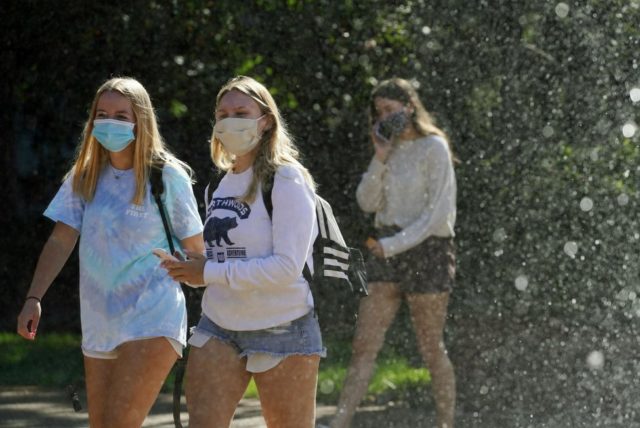Jan. 13 (UPI) — More than half of colleges across the country reported “spikes” in COVID-19 cases, suggesting students and others may be “super-spreaders,” according to a study published Wednesday by the journal Computer Methods in Biomechanics and Biomedical Engineering.
The analysis of 30 colleges and universities from across the United States found that more than half, at their peak, had more than 1,000 cases of the virus per 10,000 people on campus, the data showed.
The findings add to the fear that students and staff members sickened during these campus outbreaks could further spread the virus to the rest of the country, the researchers said.
“We found that colleges are at high risk of becoming super-spreaders of COVID-19,” study co-author Ellen Kuhl told UPI.
“Specifically, the most high risk periods are the first two weeks of instruction, when students have just moved to campus and, during these times, campus outbreaks have been extreme,” said Kuhl, chair of the mechanical engineering department at Stanford University in California.
These outbreaks “rapidly translated into the neighboring communities” even though “campuses were able to manage them well,” she said.
Since the start of the pandemic last March, many colleges and universities across the country closed their campuses and shifted classes to remote, online formats.
In the fall, some schools reopened campuses to students enrolled in programs that required in-person learning, such as the sciences, with strict COVID-19 testing and contact tracing protocols in place.
Still, despite their efforts, many experienced on-campus outbreaks, forcing closures and returns to distance learning approaches, Kuhl and her colleagues found.
Earlier this week, Stanford University decided to keep undergraduates away for its winter quarter, Kuhl said.
For this study, the researchers used a technique called advanced modelling, which assesses the real-time trends of a COVID-19 outbreak to map how the disease spread.
The researchers used publicly available COVID-19 case data on the 30 colleges, which were teaching in person, online or via a hybrid of both in the fall.
All campuses had implemented regular surveillance testing, weekly or even twice per week, combined with aggressive test-trace-isolate strategies, according to the researchers.
Despite these protocols, all 30 institutions reported more than 50 cases per 100,000 people in the campus population on a weekly basis during the fall, the data showed.
That’s the threshold public health officials use to identify regions at “high risk,” the researchers said.
Seventeen of the 30 schools reported spikes that significantly exceeded 1,000 COVID-19 cases per 100,000 people per week within the first two weeks of class during the fall semester, according to the researchers.
At the University of Notre Dame, for example, all 12,607 students were tested before the beginning of the fall semester, and only nine were positive, the researchers said.
However, fewer than two weeks into the term, the seven-day case rate was 3,083 per 100,000 people in the campus population, meaning each infected person passed the virus on to more than three others, according to the researchers.
On some campuses, one in five students had been infected with the virus by the end of the fall term, and four institutions had more than 5,000 cases. These campus outbreaks translated directly into peaks of infection within their home counties, the researchers said.
Still, with about 90 reported deaths nationwide, mainly college employees and not students, the campus-related death rate of 0.02% remains well below the national average for COVID-19, according to the researchers.
The findings of the analysis “confirm the widespread fear in early fall that colleges could become the new hot spots of COVID-19 transmission,” Kuhl said.
However, campus administrators should be “applauded for their rapid responses” to outbreaks, which were often more effective at controlling spread of the virus than those implemented in their surrounding communities, she said.
Indeed, the analysis suggests that “tight outbreak management,” including the immediate transition from in-person to all online learning, can reduce the infection peaks within about two weeks, she said.
Although “overall, case numbers are much higher now than when fall quarter started, many colleges have taken incredible measures to control and contain local spread,” Kuhl told UPI.
“We can clearly see that campuses have been able to manage local outbreaks much quicker and more efficiently than the surrounding communities,” she said.

COMMENTS
Please let us know if you're having issues with commenting.